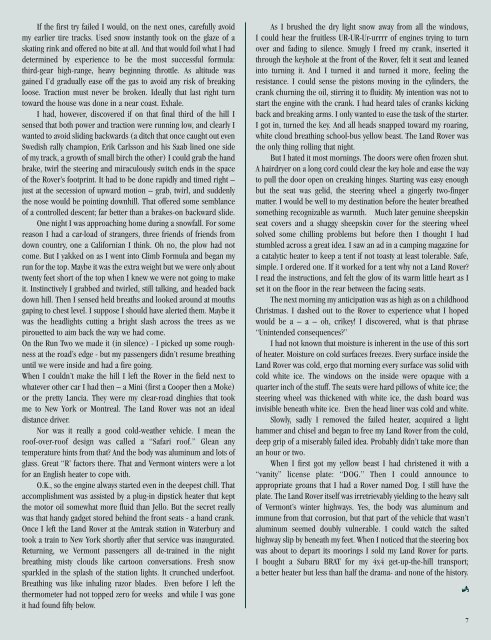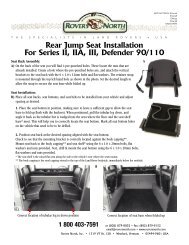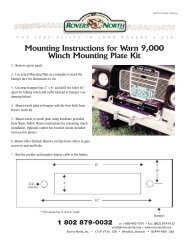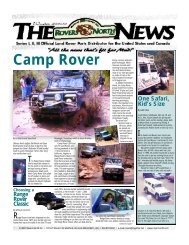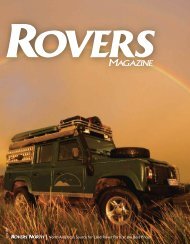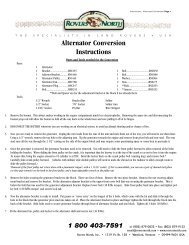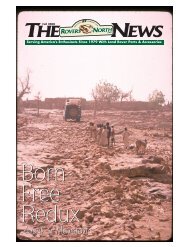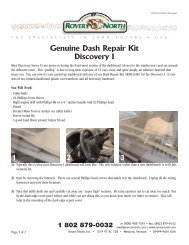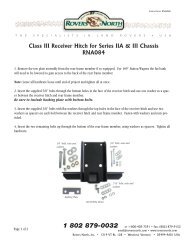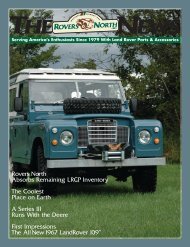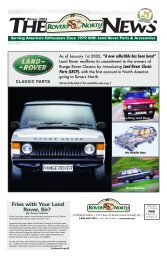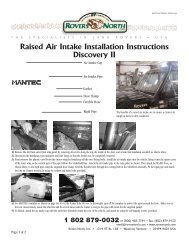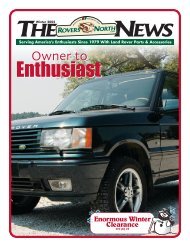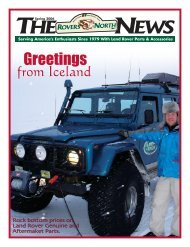Create successful ePaper yourself
Turn your PDF publications into a flip-book with our unique Google optimized e-Paper software.
If the first try failed I would, on the next ones, carefully avoid<br />
my earlier tire tracks. Used snow instantly took on the glaze of a<br />
skating rink and offered no bite at all. And that would foil what I had<br />
determined by experience to be the most successful formula:<br />
third-gear high-range, heavy beginning throttle. As altitude was<br />
gained I’d gradually ease off the gas to avoid any risk of breaking<br />
loose. Traction must never be broken. Ideally that last right turn<br />
toward the house was done in a near coast. Exhale.<br />
I had, however, discovered if on that final third of the hill I<br />
sensed that both power and traction were running low, and clearly I<br />
wanted to avoid sliding backwards (a ditch that once caught out even<br />
Swedish rally champion, Erik Carlsson and his Saab lined one side<br />
of my track, a growth of small birch the other) I could grab the hand<br />
brake, twirl the steering and miraculously switch ends in the space<br />
of the Rover’s footprint. It had to be done rapidly and timed right –<br />
just at the secession of upward motion – grab, twirl, and suddenly<br />
the nose would be pointing downhill. That offered some semblance<br />
of a controlled descent; far better than a brakes-on backward slide.<br />
One night I was approaching home during a snowfall. For some<br />
reason I had a car-load of strangers, three friends of friends from<br />
down country, one a Californian I think. Oh no, the plow had not<br />
come. But I yakked on as I went into Climb Formula and began my<br />
run for the top. Maybe it was the extra weight but we were only about<br />
twenty feet short of the top when I knew we were not going to make<br />
it. Instinctively I grabbed and twirled, still talking, and headed back<br />
down hill. <strong>The</strong>n I sensed held breaths and looked around at mouths<br />
gaping to chest level. I suppose I should have alerted them. Maybe it<br />
was the headlights cutting a bright slash across the trees as we<br />
pirouetted to aim back the way we had come.<br />
On the Run Two we made it (in silence) - I picked up some roughness<br />
at the road’s edge - but my passengers didn’t resume breathing<br />
until we were inside and had a fire going.<br />
When I couldn’t make the hill I left the Rover in the field next to<br />
whatever other car I had then – a Mini (first a Cooper then a Moke)<br />
or the pretty Lancia. <strong>The</strong>y were my clear-road dinghies that took<br />
me to New York or Montreal. <strong>The</strong> Land Rover was not an ideal<br />
distance driver.<br />
Nor was it really a good cold-weather vehicle. I mean the<br />
roof-over-roof design was called a “Safari roof.” Glean any<br />
temperature hints from that? And the body was aluminum and lots of<br />
glass. Great “R’ factors there. That and Vermont winters were a lot<br />
for an English heater to cope with.<br />
O.K., so the engine always started even in the deepest chill. That<br />
accomplishment was assisted by a plug-in dipstick heater that kept<br />
the motor oil somewhat more fluid than Jello. But the secret really<br />
was that handy gadget stored behind the front seats - a hand crank.<br />
Once I left the Land Rover at the Amtrak station in Waterbury and<br />
took a train to New York shortly after that service was inaugurated.<br />
Returning, we Vermont passengers all de-trained in the night<br />
breathing misty clouds like cartoon conversations. Fresh snow<br />
sparkled in the splash of the station lights. It crunched underfoot.<br />
Breathing was like inhaling razor blades. Even before I left the<br />
thermometer had not topped zero for weeks and while I was gone<br />
it had found fifty below.<br />
As I brushed the dry light snow away from all the windows,<br />
I could hear the fruitless UR-UR-Ur-urrrr of engines trying to turn<br />
over and fading to silence. Smugly I freed my crank, inserted it<br />
through the keyhole at the front of the Rover, felt it seat and leaned<br />
into turning it. And I turned it and turned it more, feeling the<br />
resistance. I could sense the pistons moving in the cylinders, the<br />
crank churning the oil, stirring it to fluidity. My intention was not to<br />
start the engine with the crank. I had heard tales of cranks kicking<br />
back and breaking arms. I only wanted to ease the task of the starter.<br />
I got in, turned the key. And all heads snapped toward my roaring,<br />
white cloud breathing school-bus yellow beast. <strong>The</strong> Land Rover was<br />
the only thing rolling that night.<br />
But I hated it most mornings. <strong>The</strong> doors were often frozen shut.<br />
A hairdryer on a long cord could clear the key hole and ease the way<br />
to pull the door open on creaking hinges. Starting was easy enough<br />
but the seat was gelid, the steering wheel a gingerly two-finger<br />
matter. I would be well to my destination before the heater breathed<br />
something recognizable as warmth. Much later genuine sheepskin<br />
seat covers and a shaggy sheepskin cover for the steering wheel<br />
solved some chilling problems but before then I thought I had<br />
stumbled across a great idea. I saw an ad in a camping magazine for<br />
a catalytic heater to keep a tent if not toasty at least tolerable. Safe,<br />
simple. I ordered one. If it worked for a tent why not a Land Rover?<br />
I read the instructions, and felt the glow of its warm little heart as I<br />
set it on the floor in the rear between the facing seats.<br />
<strong>The</strong> next morning my anticipation was as high as on a childhood<br />
Christmas. I dashed out to the Rover to experience what I hoped<br />
would be a – a – oh, crikey! I discovered, what is that phrase<br />
“Unintended consequences?”<br />
I had not known that moisture is inherent in the use of this sort<br />
of heater. Moisture on cold surfaces freezes. Every surface inside the<br />
Land Rover was cold, ergo that morning every surface was solid with<br />
cold white ice. <strong>The</strong> windows on the inside were opaque with a<br />
quarter inch of the stuff. <strong>The</strong> seats were hard pillows of white ice; the<br />
steering wheel was thickened with white ice, the dash board was<br />
invisible beneath white ice. Even the head liner was cold and white.<br />
Slowly, sadly I removed the failed heater, acquired a light<br />
hammer and chisel and began to free my Land Rover from the cold,<br />
deep grip of a miserably failed idea. Probably didn’t take more than<br />
an hour or two.<br />
When I first got my yellow beast I had christened it with a<br />
“vanity” license plate: “DOG.” <strong>The</strong>n I could announce to<br />
appropriate groans that I had a Rover named Dog. I still have the<br />
plate. <strong>The</strong> Land Rover itself was irretrievably yielding to the heavy salt<br />
of Vermont’s winter highways. Yes, the body was aluminum and<br />
immune from that corrosion, but that part of the vehicle that wasn’t<br />
aluminum seemed doubly vulnerable. I could watch the salted<br />
highway slip by beneath my feet. When I noticed that the steering box<br />
was about to depart its moorings I sold my Land Rover for parts.<br />
I bought a Subaru BRAT for my 4x4 get-up-the-hill transport;<br />
a better heater but less than half the drama- and none of the history.<br />
P<br />
7


